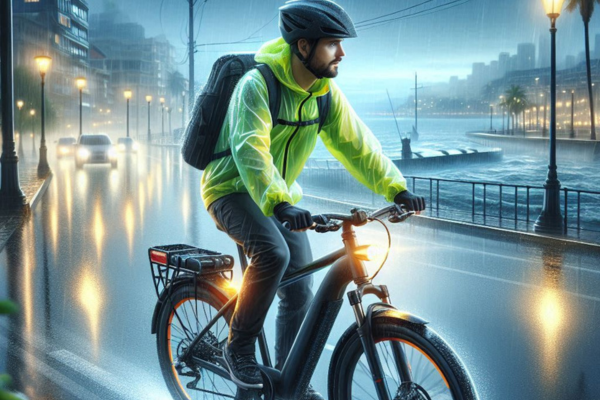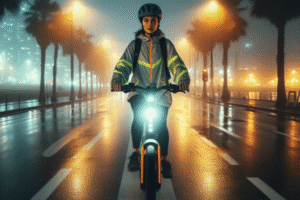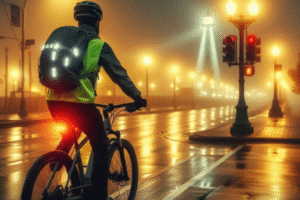🌧️ Wet Weather Visibility: Essential Guide for Coastal E-Bike Commuters
Riding an electric bicycle in the rain may seem daunting at first—especially in coastal cities, where weather conditions can shift rapidly from sun to storm. But visibility is not a luxury; it’s a necessity. For e-bike commuters navigating through misty mornings, salty sea spray, and reflective wet streets, visibility becomes the cornerstone of a safe and confident ride. This guide offers a deep dive into the practical strategies, gear, and mindset needed to maintain optimal visibility during wet conditions in coastal environments. More than just a list of tips, it’s a call to ride smarter, safer, and with greater presence.
🌊 The Coastal Context: Why Wet Weather Demands More
Coastal cities have their own rhythm—and their own risks. Morning fog can reduce visibility to just a few meters. Rain often comes in waves, driven by ocean winds, making it unpredictable and intense. Salt in the air, though invisible, accumulates on surfaces and corrodes metal and electronics alike. These environmental factors create a perfect storm of reduced visibility, both for the cyclist and for those around them. A poorly lit rider wearing dark clothing can become nearly invisible under streetlights blurred by rain and fog.
Visibility, therefore, is more than just being seen—it’s being recognized and anticipated by others. In wet weather, this becomes harder. Drivers’ windshields fog up. Their reaction times slow. Pedestrians walk faster and may cross suddenly. Without strong visibility, an e-bike rider becomes a shadow in motion. In coastal areas, that risk is amplified.
📌 What Visibility Really Means in Wet Conditions
Most people associate visibility with lights, and while lights are crucial, they are only part of the solution. Visibility also includes your outline, your reflectivity, your motion signature, and your color contrast against the urban background. Wet weather changes how all of these are perceived. A bright jacket may look dull when soaked. Reflective strips can blur in the rain. Side visibility becomes as important as front or back lighting. Your entire presence must be intentional and layered.
Think of visibility in three layers:
- Active visibility: Lights that illuminate your path and signal your position.
- Passive visibility: Reflective gear and materials that bounce light back to drivers and others.
- Contextual visibility: Choosing routes, colors, and gear that contrast with fog, buildings, and low light.
🧠 A True Story from the Coast
Carlos, a daily e-bike commuter in Barranquilla, Colombia, shared his near-miss experience during a pre-dawn ride in the rainy season. He had just installed a new headlight but hadn’t added side reflectors yet. As he crossed a low-lit intersection, a delivery van turning left nearly clipped his rear wheel. The driver later told him, “I saw your light, but not your bike.” Carlos immediately upgraded his setup with reflective ankle straps, spoke lights, and a waterproof neon vest. “Since then,” he says, “I haven’t had a single close call.” His story reminds us that visibility is not about one item—it’s about layers that build presence.
📍 Key Reasons Visibility Fails in Coastal Rain
| Visibility Factor | Why It Fails | Coastal Solution |
|---|---|---|
| Lights dimmed by moisture | Fog and salt film block brightness | Clean and dry after every ride |
| Dark clothing under low light | Blends into surroundings when wet | Wear bright, high-contrast waterproof gear |
| No side reflectivity | Drivers only see front/rear flashes | Use spoke lights and reflective patches |
🌟 A Shift in Perspective
Visibility is not about vanity. It’s about your safety, your freedom to ride with peace of mind, and your power to take up space on the road—even when the rain tries to erase you. In coastal cities, every layer of visibility you add is a layer of security. Don’t wait for a close call to realize how vital it is. Equip yourself. Light up your path. And ride knowing that you’re not just commuting—you’re claiming your presence, confidently and clearly.
💡 Smart Lighting for Rainy Coastal Rides: Be Seen from Every Angle
Lighting is the first line of defense when it comes to visibility. In a coastal city, where wet conditions and fog can roll in with little warning, your lights need to do more than flicker—they need to announce your presence boldly and from all angles. Choosing the right lighting system is about more than lumens; it’s about coverage, durability, placement, and behavior in wet, reflective environments. This section will guide you through the layers of smart lighting every coastal e-bike rider should consider.
🔦 What Makes Lighting “Smart” in Coastal Weather?
Smart lighting systems are not just powerful—they are adaptive, weather-resistant, and strategically placed. In coastal rain, lights must pierce through fog, remain functional after exposure to salty mist, and grab the attention of drivers and pedestrians on slick, visually noisy streets.
To qualify as “smart” in a coastal context, your lighting setup should meet these criteria:
- High lumen output: Minimum 500 lumens in front, 50 in the rear, with steady and flashing modes.
- Wide-angle beam: Covers more road and sidewalk space, enhancing side visibility.
- Waterproof rating: IPX6 or higher to handle downpours and coastal spray.
- Battery indicator: Alerts you before power runs out in the middle of a ride.
- Multiple mounting positions: Front handlebars, seat post, helmet, and frame sides.
💡 Case Example: Daniel’s Upgrade in Santa Marta
Daniel, a night shift nurse in Santa Marta, used to ride with a basic headlight and a single rear blinker. After nearly being sideswiped in dense fog, he invested in a smart light kit with a front beam, side LEDs, and brake-light signaling. “The difference was night and day,” he said. “Drivers actually slow down now when they see me. I’m not just a shadow anymore.” His experience shows how visibility is often the result of configuration—not just brightness.
📋 Ideal Lighting Setup for Coastal Rains
| Component | Recommended Specs | Purpose |
|---|---|---|
| Front Headlight | 500–800 lumens, IPX6, adjustable angle | Forward illumination + signaling presence |
| Rear Light | 50+ lumens, flashing + steady modes | Alerts traffic behind you |
| Side Lights | Spoke-mounted or frame strips, 360° LEDs | Critical for intersections and crosswinds |
| Helmet Light | Rear red or top-mounted beam | Increases vertical visibility in traffic |
⚡ Don’t Forget These Lighting Add-Ons
- Brake detection: Some systems flash brightly when decelerating.
- Turn signal vests: Controlled from the handlebar, ideal for city lanes and rain-obscured gestures.
- Glow-in-the-dark paint: For frames or wheels, stays visible even when lights fail.
🌀 Visual Thinking: You Are a Lighthouse on Wheels
Picture yourself riding along the coastal road at dusk. The rain falls sideways, headlights shimmer off the wet asphalt, and fog hovers near the sea. In this low-visibility world, you become a moving beacon—a lighthouse in motion. Your lighting system is not just decoration; it’s communication. It says: “Here I am. I’m moving. Give me space.”
“Good lighting doesn’t just reveal the road—it declares your existence in the storm.” 🌧️🚴♀️
With the right lighting setup, you won’t just ride—you’ll shine, even when the skies go dark and the streets blur with water. Be strategic, be seen, and let your lights do the talking when the rain begins to fall.
🧥 Reflective and Waterproof Clothing for Coastal Rides: Visibility You Can Wear
When rain begins to fall in a coastal city, your visibility drops—and not just for others trying to see you, but for your own ability to stand out in an already hazy, dim environment. That’s why what you wear becomes as critical as your lighting system. Reflective and waterproof clothing isn’t just about staying dry—it’s about being immediately recognizable to every driver, cyclist, and pedestrian who shares the road. In this section, we’ll explore what gear works best in wet coastal conditions, how to layer for comfort and safety, and why fashion and function must go hand in hand for e-bike commuters.
🌦️ The Science of Wet Fabric and Visibility Loss
Clothing behaves differently when soaked. A neon yellow jacket may darken to a dull green. Reflective strips can become less effective when covered in water or dirt. Cotton and untreated materials absorb moisture and cling to the body, becoming heavy and uncomfortable. These issues are amplified in coastal settings, where humidity and sea spray make it hard for anything to stay dry for long.
To remain visible and comfortable, e-bike commuters must use fabrics designed for wet conditions. The best garments repel water, maintain color contrast when soaked, and incorporate 360-degree reflectivity. Ideally, these items are also breathable, since the combination of warm rain and pedaling can make overheating a real concern.
👕 Layering Smart: A Three-Tier Approach
Effective coastal rainwear isn’t about piling on thick gear—it’s about layering wisely. Here’s the ideal setup:
- Base layer: Lightweight and moisture-wicking to keep sweat off your skin.
- Mid layer: Insulating but breathable, depending on temperature. Fleece or softshell fabrics work well.
- Outer layer: Fully waterproof with taped seams and reflectors on all sides. Look for a hood that fits over your helmet and sleeves that seal at the wrists.
📊 Coastal vs. Urban Cycling Apparel: What’s Different?
| Feature | Urban Rain Gear | Coastal Rain Gear |
|---|---|---|
| Material Type | Water-resistant | Fully waterproof + salt-resistant |
| Reflective Coverage | Front and back only | 360° reflectivity with arm and side bands |
| Color Retention | Fades when wet | Stays bright in rain and mist |
| Breathability | Moderate | High, designed for humid climates |
🎒 Accessories That Elevate Your Visibility
- Reflective backpack covers: Waterproof and bright, often with integrated LEDs.
- Helmet covers: Fluorescent and rainproof, some with rear-facing reflectors.
- Shoe gaiters or reflective overshoes: Keep feet dry and help moving legs remain visible to drivers.
- Waterproof gloves: Improve grip in rain and include reflectivity for hand signaling.
🌀 Visual Insight: How You Look in the Rain
Imagine watching two cyclists pass in heavy coastal rain. One wears a dark hoodie, soaked jeans, and no reflectors. The other is in a high-vis jacket with glowing arm bands, wheel lights, and a flashing rear vest. One fades into the background, barely visible. The other commands attention—even through the downpour. Which one would you want to be?
“Your clothing is more than protection—it’s a signal. A glowing banner that says, ‘I’m here. Give me space.’” 🌧️🧥🚲
Visibility begins with what you wear. In wet coastal environments, it’s your first defense, your comfort zone, and your statement. Dress like you mean to arrive safely—because you do.
🛠️ Preventive Maintenance for Coastal Rain: Protecting Your Ride and Your Visibility
Visibility isn’t just about what you wear or how bright your lights are—it’s also about how well you maintain your e-bike in between rides. In coastal cities, the challenges go far beyond rain. The salty air, high humidity, and fine sand particles can all sneak into your bike’s mechanical and electrical systems, degrading them silently. Over time, this damages your visibility tools, compromises your safety, and shortens the lifespan of your entire setup.
To prevent this, coastal commuters need a reliable and simple maintenance routine that protects lights, reflectors, moving parts, and power systems. Think of it as visibility insurance: the better you care for your equipment, the brighter and more dependable it will remain, ride after ride—even in a storm.
🌧️ The Hidden Threats of Coastal Humidity
Riding in coastal environments means dealing with constant moisture. Even on days without rain, the humidity in the air—and the salt content within it—begins a slow attack on everything metallic or electric. Over time, you may notice:
- ☑️ Lights flickering or dimming due to corrosion in the connectors
- ☑️ Rust forming on bolts and reflectors
- ☑️ Brakes and gears becoming stiff or squeaky
- ☑️ Reduced battery efficiency in consistently damp conditions
All of this translates to less visibility and more mechanical risk. But with a few intentional habits, you can turn your rainy-day e-bike into a year-round powerhouse.
🔧 Weekly Maintenance Checklist for Coastal Riders
- Clean lights and reflectors: Use a microfiber cloth and lens-safe cleaner to remove salt, fog film, and grime.
- Inspect cables and battery ports: Look for moisture or discoloration. Use dielectric grease to protect exposed metal parts.
- Dry after every ride: Towel-dry your bike—especially under the seat, around the light housings, and near the motor or battery.
- Lubricate the chain: Use wet-weather chain lube designed to resist saltwater corrosion.
- Check light output: If brightness fades or lights flicker, replace batteries or check for loose or corroded contacts.
📊 Visibility Failures and Their Coastal Fixes
| Issue | Cause | Solution |
|---|---|---|
| Dim headlight beam | Salt or fog buildup on lens | Clean with soft cloth weekly |
| Flickering rear light | Corroded contact points | Apply dielectric grease, store indoors |
| Rusty reflectors or brackets | Constant exposure to sea air | Switch to stainless steel or coat with rust-inhibitor spray |
| Battery discharges quickly | Humidity inside casing | Keep bike in a dry, shaded place |
🧠 Real-World Story: Valentina’s Visibility Routine
Valentina, who rides her e-bike daily along the waterfront in Santa Marta, noticed her rear light failing more often during the rainy season. After a near miss one evening, she implemented a simple after-ride routine: she dries the light housing with a soft towel, adds a drop of lubricant to the USB port seal, and stores her bike on a raised mat inside her hallway. “Since then,” she says, “my visibility gear hasn’t failed me once.” Her story reminds us that consistency in small actions builds long-term safety.
💡 A Mindset of Maintenance Is a Mindset of Self-Respect
Preventive maintenance is not a burden—it’s an act of self-respect. It says, “I care enough about my safety and my experience to prepare for what nature might throw at me.” In coastal riding, your relationship with your bike becomes more intimate: you notice its quirks, anticipate its needs, and treat its visibility tools like the guardians they are. When you do this, your bike becomes more than a machine—it becomes a trusted partner, rain or shine.
“A well-maintained bike is a bright, dependable voice in the storm. Silence that voice, and you risk disappearing.” 🌧️🛠️
❓ Frequently Asked Questions: Staying Visible in Coastal Rain
1. Is high-visibility clothing enough to stay safe during coastal rain?
No. High-visibility clothing is an important layer of visibility, but not the only one. In coastal conditions where fog and heavy rain reduce contrast, you also need active visibility like lights and passive elements like reflectors. A full system approach—clothing, lighting, and bike setup—is what keeps you truly safe.
2. Can my e-bike lights get damaged by sea air?
Yes. Salty mist can corrode the wiring and connectors of your lighting system. Always choose lights rated IPX6 or higher for water resistance and apply dielectric grease to electrical contact points. Store your e-bike indoors or under cover whenever possible.
3. How often should I clean visibility gear in coastal weather?
Ideally after every wet ride. Salt and sand create a film over lenses, reflectors, and fabrics, reducing their effectiveness. Use a soft, damp cloth to wipe surfaces and gently dry electrical components with a towel. A 5-minute habit makes a big difference.
4. Are smart vests and brake-reactive lights worth it?
Absolutely. These tools enhance your visibility by communicating your intentions to others—especially useful when hand signals become less visible due to rain, gloves, or reduced lighting. A smart vest with turn signals can prevent close calls at intersections or roundabouts.
5. What if I only ride short distances—do I still need all this gear?
Yes. Coastal rain can be intense even over a few blocks. A 10-minute ride in low visibility without proper equipment can still put you at risk. Think of visibility gear as a safety belt: short trip or long journey, it should always be on.
🤝 A Community of Visible Riders
Being seen isn’t just about safety—it’s about empowerment. Every time you prepare for a wet coastal ride with lights, gear, and care, you’re not just protecting yourself. You’re sending a message to your community: “We belong here, rain or shine.”
E-bike riders in coastal cities share a unique bond—we navigate unpredictable weather, rough terrain, and blurred horizons. And yet, we ride with grace and confidence. By sharing tips, stories, and routines, we strengthen not just our own safety, but the culture of cycling itself. Let your visibility be an invitation—for others to ride, to respect, and to protect.
💛 Final Thoughts: You Deserve to Be Seen
Visibility is more than light. It’s presence. It’s dignity. It’s claiming your place on the road, even when the rain tries to erase you. In coastal cities, where nature often leads the dance, you become your own beacon—with every light, every reflective patch, every careful habit you adopt.
So wear that vest. Charge that light. Wipe down your reflectors. Because every time you show up prepared, you’re not just riding—you’re inspiring. You remind the world that sustainability, safety, and courage can coexist—even under gray skies.
“To be visible is to be respected. In the rain, in the wind, in the chaos—shine anyway.” 🌧️🚴♀️💫
Thank you for riding with intention. For respecting yourself enough to prepare. And for being part of a coastal community that moves forward—even when the clouds roll in.



